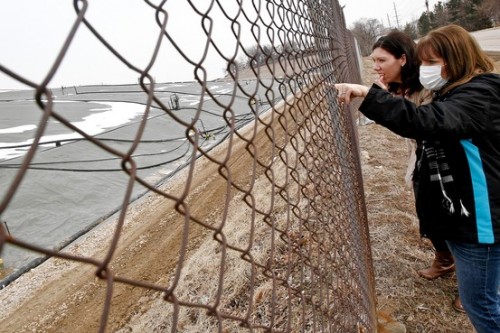The Wall Street Journal
by John R. Emshwiller
Updated July 24, 2014 1:19 p.m. ET
Dawn Chapman, left, and Karen Nickel visit the West Lake landfill March 5. Ms. Chapman and Ms. Nickel are part of a watchdog group of residents concerned about the radioactive sites and the fire smoldering beneath the landfill. Sarah Conard for The Wall Street Journal
ST. LOUIS—Pressure is mounting to deal with the legacy of radioactive contamination and possible damage to human health caused by work done in this region for the U.S. nuclear-weapons program.
A state environmental consultant recently warned that a “subsurface smoldering event,” caused by garbage heating up underground, might be heading toward a section of the West Lake landfill, where thousands of tons of radioactive garbage is buried. The landfill’s owner strongly disagreed with the consultant’s findings.
Patty Ameno has spent the last quarter century fighting to clean up nuclear waste in and around Apollo, her home town in western Pennsylvania.
WSJ’s John Emshwiller and Jeremy Singer-Vine detail their year-long investigation into the fate of hundreds of Cold War-era nuclear manufacturing and research sites.
Federal regulators meanwhile are testing for more possible radioactive contamination in a suburban St. Louis area, while local health officials are adding staff for a possible major radiation-related health study of current and former residents of some neighborhoods.
“There is a lot of debate and controversy going on,” said Kay Drey, a local activist who has been working on nuclear issues here for decades. “It is time to finish cleaning up this area.”
The Wall Street Journal’s Waste Land series examined the St. Louis area last year, one of several reports last year on the legacy of contamination from the U.S. atomic-weapons program. Starting in World War II, local factories processed large amounts of weapons-related uranium. For years, there have been efforts to clean up the resulting mess at dozens of properties.
The U.S. Environmental Protection Agency recently took soil samples from an athletic complex where testing by a citizens group had raised questions about possibly elevated contamination levels.
The EPA said it expects to announce results near the end of this month. Past testing didn’t show a problem at that site, the EPA said, though another citizens group recently challenged such assurances.
The Journal has compiled a database on hundreds of sites around the country. Use it to look up places near you and learn more about them.
The St. Louis County Department of Health is hiring a team of epidemiologists whose projects may include a health study related to the past nuclear-weapons work. A group of current and former residents have been using Facebook to gather information on hundreds of cases of cancers and other maladies in neighborhoods they believe were contaminated by atomic waste.
While the citizens’ data isn’t scientifically validated, “it was a great idea of people to use social media” to gather information, said Dr. Dolores Gunn, director of the St. Louis County health department. “It gives us a place to start.”
At the West Lake landfill, a report last month from a consultant for the Missouri Department of Natural Resources said that underground temperature readings in part of the site suggest underground smoldering is moving toward the landfill’s radioactive waste.
A spokesman for Republic Services Inc., West Lake’s owner, said evidence indicates the smoldering is moving away from the nuclear waste. Even if the heat reached that waste, scientific data “strongly indicates” it wouldn’t present a public-health threat, he said.
However, an EPA report earlier this year said that if heated, the nuclear waste could put increased amounts of radioactive radon into the air.
The EPA and Republic Services are working toward building an underground “isolation barrier” between the radioactive waste and the smoldering event, though they say the chance of the two meeting is small.
Federal and state officials are worried about the pace of the barrier work. Four members of the Missouri congressional delegation, including the state’s two senators, wrote the EPA last week expressing concern about “the lack of a clear timeline for completion.”
“I am not getting solid answers as to when the construction will begin and when it ends,” Missouri Attorney General Chris Koster said at a recent news conference. A spokesman for Mr. Koster said his office has been told preliminary testing results indicate that radioactive material is being found across a wider area of the dump than previously believed.
An EPA spokesman said the agency understands the frustration of elected officials. But he said of the isolation barrier, “We want to get it right, and getting it right takes time.”

